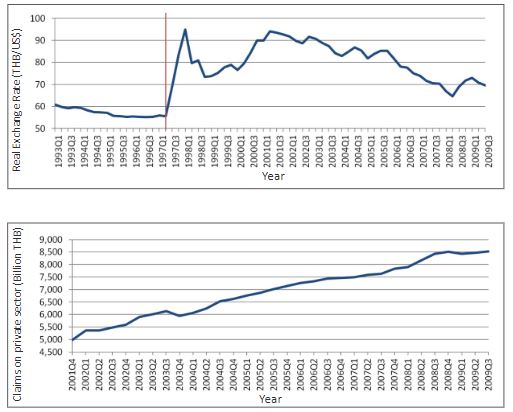Computable General Equilibrium of Real Estate and Financial Crisis Vulnerability
DOI:
https://doi.org/10.56261/built.v11.167870Keywords:
Computable General Equilibrium (CGE), Real Estate, ThailandAbstract
Growth in the economy of Thailand is highly related to the role of the real estate industry. While the frameworks of Social Accounting Matrix (SAM) and Computable General Equilibrium (CGE) show the interaction between real estate and other sectors in the real economy, the flow of funds accounts and Financial SAM reveals the more realistic picture of the connection between real estate and the financial market. A Financial CGE model is used to investigate the role of real estate investment in the economy of Thailand. This study discusses how the over-invested real estate market can cause the country to be vulnerable to a financial crisis. In addition, the relationship of real estate asset and property markets is incorporated into the model to capture interconnections between production sectors and financial sectors. The macroeconomic and socioeconomic indicators from the model simulation show that moderate investment in real estate sectors can lead to steady economic growth with small impacts on income disparity. In addition, various policy implications can be applied to mitigate the negative effects from real estate investment in Thailand. The analysis suggests that moderate growth in the real estate sector is desirable.
Downloads
References
Azis, I. J. (2002). A new approach to modeling the impacts of financial crisis on income distribution and poverty. ADBI Research Paper Series, 35, 1-33.
Bank of Thailand (n.d.). Statistics. Retrieved March 2011, from https://www.bot.or.th/Thai/Statistics/Pages/ default.aspx.
Bernanke, B., & Blinder, A. (1988). Credit, money and aggregate demand. American Economic Review Papers and Proceedings, 78(2), 435-439.
Bouguignon, F., Branson, W. H., & De Melo, J. (1989). Adjustment and income distribution: A counterfactual analysis (NBER Working Paper, no. 2943). Washington, DC.: World Bank.
Brunner, K., & Meltzer, A. (1972). Money, debt, and economic activity. Journal of Political Economy, 80, 951-977.
Daniere, A. G. (1995). Transportation planning and implementation in cities of the Third World: The case of Bangkok. Environment and Planning C: Government and Policy, 13(1), 25-45.
DiPasquale, D., & Wheaton, W. C. (1992). The markets for real estate asset and space: A conceptual framework. Journal of the American Real Estate & Urban Economics Association, 20(2), 181-197.
DiPasquale, D., & Wheaton, W. C. (1994). Housing market dynamics and the future of housing prices. Journal of Urban Economics, 35(1), 1-27.Dowall, D. E. (1989). Bangkok: A profile of an efficiently performing housing market. Urban Studies, 26(3), 327-339.
Fiscal Policy Research Institute. (n.d.). Macroeconomics & Finance. Retrieved November 2010, from http:// www.fpri.or.th/wp/?cat=6#.XCFe81wzaUk.
International Monetary Fund [IMF]. (n.d.). International financial statistics. Retrieved November 2010, from http://data.imf.org/?sk=4C514D48-B6BA-49ED-8AB9- 52B0C1A0179B.
Manopiniwes, C. (2005). A Computable General Equilibrium (CGE) model for Thailand with financial and environmental linkages: The analysis of selected policies. USA.: Cornell University.
Mansury, Y. S. (2002). Nonlinear impacts of the Asian financial crisis on income distribution in Indonesia: A financial computable general equilibrium approach. USA.: Cornell University.
Office of the National Economic and Social Development Board. (2009). National account. Retrieved from http:// www.nesdb.go.th/nesdb_en/mainphp?filename=national_account.
Pholphirul, P., & Rukumnuaykit, P. (2009). Real estate cycle and real business cycle: An evidence from Thailand. Pacific Rim Property Research Journal, 15(2), 145-165.
Puttanapong, N. (2008). The Computable General Equilibrium (CGE) models with Monte-Carlo simulation for Thailand: an impact analysis of Baht appreciation. USA: Cornell University.
Rosenzweig, J. A., & Taylor, L. (1990). Devaluation, capital flows, and crowding-out: A CGE model with portfolio choice for Thailand. In Taylor, L. (ed.), Socially relevant policy analysis, structuralist computable general equilibrium models for the developing world. Cambridge, Massachusetts.
SCB Economic Intelligence Center. (2013). Thailand... Strengths, Weaknesses, and limitations are waiting for unlocking. Money & Banking Magazine, 32(374), n.d.
The Economist Intelligence Unit Database. (2010). Country data. Retrieved from https://store.eiu.com/product/ countrydata.
Thorbecke, E., & Downey, R. (1992). Adjustment and equity in Indonesia. Paris: Development Centre of the Organisation for Economic Co-operation and Development.
Tobin, J. (1969). A general equilibrium approach to monetary theory. Journal of Money, Credit and Banking, 1(1), 15-29.
Vongpradhip, D. (1987). A CGE model with real and financial sector linkages. Bangkok, Thailand: Thailand Development Research Institute Foundation.

Downloads
Published
How to Cite
Issue
Section
License

This work is licensed under a Creative Commons Attribution-NonCommercial-NoDerivatives 4.0 International License.











